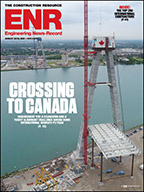American Bridge-Kraemer Team Apparent Low Bidder on Wilson Bridge Drawspan
A joint venture of American Bridge Co., Coraopolis, Pa., and Edward Kraemer & Sons Inc., Plain, Wisc., is the apparent low bidder to build the bascule portion of the new Woodrow Wilson bridge across the Potomac River. The American Bridge-Kraemer bid was $185.9 million, or 11% above the Maryland State Highway Administration's $168-million engineers' estimate, but SHA Administrator Parker Williams indicated it was in the acceptable range. After proposals were opened Nov. 7 in Baltimore, he said, "I think we've got a workable bid here."
 |
| Rendering of drawspan for new Wilson bridge (Photo courtesy of Parsons Corp.) |
There was a big gap between the low bid and the second-low proposal, from a team of Cianbro Corp., Pittsfield, Maine, and Weeks Marine Inc., Cranford, N.J. The Cianbro-Weeks bid was $221.3 million, which was $35.4 million, or 19%, higher than American Bridge-Kraemer's.
The other contenders were: Tidewater Skanska-Taylor, Virginia Beach, Va., at $241.96 million; Perini/Tutor-Saliba/O&G, Hawthorne, N.Y., at $242.3 million; and FruCon Construction Corp. Ballwin, Mo.-Cleveland Bridge, at $244.7 million.
"We're excited," says Brad Saver, senior estimator with American Bridge. Asked to explain the reasons for the spread in bids, he says, "I don't have a way to know how [the other teams] bid, so I couldn't really tell you."
Cianbro doesn't plan to challenge the result, says Mac Cianchette, the company's vice president of operations. "We're sorry we lost the job," Cianchette says. Noting that there was a gap between Cianbro's bid and the tightly bunched prices from the third, fourth and fifth bids, Cianchette says, "We can only assume that we had a different plan to build the project." He adds, "And we're really baffled at the spread between us and the low bidder."
The bridge is the centerpiece of a $2.44-billion project that also includes two major Capital Beltway interchange upgrades on each side of the river. The new crossing would replace the existing 40-year-old Wilson bridge, which has been battered by much higher traffic volumes than originally envisioned.
The contract includes building the bascule sections of both of the parallel, six-lane spans, as well as constructing the bridge operator's tower and demolishing the drawspan on the current six-lane bridge.
Maryland's Williams says, "We're delighted that we got five bids." Maryland last year had advertised the entire bridge as a single contract and was shocked that it received just one bid, which was $360 million, or 72%, above its estimate.
The state rejected that bid, from a team of Kiewit Construction Co., Tidewater Construction Corp. and Clark Construction Co., and hired a committee of consultants, led by Tom Warne, former head of the Utah Dept. of Transportation. That panel's recommendations included breaking up the job into three contracts to get more bidders and, it hoped, better prices.
Although the drawspan bid is $17.9 million above Maryland's estimate, Williams says the state is about 4% below its total budget to date, because nine of the state's 10 other contacts awarded so far on the Wilson project have come in below estimates.
He says state highway officials will review the bid and hope to make an award by January. A notice to proceed would come in March.
With the rebidding, "We've lost about a year," Williams says. The first six-lane span is now slated to open in late 2005 or early 2006, with the second crossing to open two years later.

